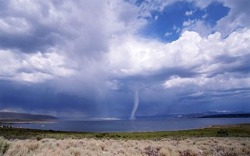VECs
Valuable ecosystem components (VECs) are components of the environment that are identified as being important and valuable and that are given detailed consideration in the EIA process. The importance of the VECs may be determined on the basis of cultural values or scientific concern. For NovaGold, determining the future integrity of each VEC over the life of the mine was crucial in designing initiatives that would lessen environmental impacts. The VECs were identified through a comprehensive consultation with the Tahltan Nation, federal and provincial governments and other interested parties. In this EIA, the identified VECs can be classified as physical and biological components.
Physical Impacts
Concerning the potential impacts of the mine project on the physical components of the area’s environment, sediment quality, climate, air quality and noise were identified as VECs.
Sediment Quality
Climate
Air Quality
Noise
Sediment Quality

The quality of the sediments refers to the physical and chemical nature of the upper sediment layers of aquatic systems in relation to the sensitivities of aquatic organisms found in these areas. Environment Canada specifically requested that sediment quality be characterized as an independent VEC for this project, and Sediment quality studies are part of the federal Metal Mining Effluent Regulations program. Previous studies have shown that the area already possesses highly mineralized soils rich in arsenic, chromium, copper, nickel and vanadium, among others.
The following activities are predicted to have potential impacts on the quality of sediments:
• Controlled discharges:
o Scheduled release of effluent from the tailings storage facility or the filter plant
o Release of diversion channel waters
• Accidental Discharges:
o Accidental release of effluent or diversion waters due to avalanche or dam failure
o Spills at the mine site (fuels, ammonium nitrate and fuel oil, and process chemicals)
o Spills at the Porcupine aerodrome and More heliport (fuel, de-icing fluid)
o Spills at the filter plant (concentrate, surfactants, flocculants, acids)
o Spills along the access corridor (concentrate or diesel fuel)
• Siltation during construction and transport
Controlled Discharge:
During the scheduled releases from the tailings storage facility, the effluents discharged will be comprised of water (containing various chemicals and metals) as well as unsettled tailing fines. The discharge schedule was organized to give an adequate dilution of effluent with the diversion channel flows. Also, the tailings impoundment acts as a settling pond so that total suspended solids (TSS) in the effluent will conform to the levels of the government’s Metal Mining Effluent Regulations.
In the filter plant, the dewatering of the ores will be taking place. The potential effects to sediment quality by the release of effluents from the filter plant are predicted to occur in the first seven meters downstream of the diffuser in the Iskut River. Overall, loading of metals to sediment will be minor considering the small increase in water concentrations of metals and the naturally high metal concentrations already present in the Iskut River sediments.
Accidental Discharges:
A dam breach at the tailings facility could have a significant long-lasting degradation of sediment quality in Galore Creek and Scud River. Large volumes of total suspended solids and metal-enriched effluent would be released. In the case of a diesel pipeline rupture, significant amounts of fuel could be released in the environmental. Significant degradation of sediment quality could occur if a spill takes place near a waterbody, especially in wetlands and lakes where the water flow is minimal and the high quantity of sediments can absorb more contaminants.
Siltation:
During construction, there is a potential for increased total suspended solids in water due to erosion from disturbed terrain and dust from blasting. Transport can also cause more dust that can settle in waterbodies and affect sediment quality.
Mitigation:
• To decrease siltation:
– Construction of settling ponds
– Roads built away from wetlands and ponds
– Traffic speeds enforced
– Diesel and ore concentrate pipeline decrease truck traffic
• Develop and implement Sediment and Erosion Plans
• Detailed monitoring and management plans for areas of higher risk of erosion
• Revegetating slopes
• Sediment quality monitoring and follow-up has been planned
Climate

The mine project could contribute to atmospheric greenhouse gas levels and reduce large scale carbon sink due to the necessary vegetative clearing. Diesel fuel and electricity are the two energy sources for the project. Diesel will be used for all mine vehicles (except two electric shovels and two electric drills). It will also be used for transporting mining supplies from Stewart to the mine site and ore concentrate from the filter plant to the port of Stewart. The mean annual diesel consumption of the mine has been estimated at 38.5 ML. Electricity will be used for all other demands and an averaged 80 megawatts is predicted to be used annually.
Greenhouse gas emissions:
Direct GHG emissions are projected from diesel combustion and indirect emissions will come from the production of electricity. The estimated annual GHG emissions have been estimated at 121.3 kt CO2, which is lower than the rest of the metal ore mining industry.
Carbon sink: The construction of the open-pit mine, the aerodrome and all the facilities necessitate the clearing of approximately 1900 hectares of forest. This area of forest usually removes 1.5 kt of carbon per year from the atmosphere. This carbon sink will be lost from the beginning of the construction phase until the end of the operational phase. Upon closure, reforestation will be undertaken, except on the flooded mine pit and tailings pond. As a result, a carbon sink of 1.1 kt of carbon per year will be created, creating a net permanent annual carbon removal loss of 0.4 kt. This is considered negligible.
Effect on glaciers:
The warming of the climate may affect glacier mass balance in the region. This would have a potential impact on the discharge in the watershed.
Mitigation:
• Use high-efficiency technologies for diesel mining equipment
• Use electrical energy for largest mining equipment
• Consider energy efficiency when purchasing new and replacement equipment
• Consider energy efficiency policies of outside service providers when acquiring their services
• Use pipelines to move diesel and concentrate
• Replace land area cleared by reforestation during reclamation
• Conduct glacier mass balance monitoring with participation of Tahtlan Heritage Resource and Environmental Assessment Team
• Committed to climate change and glacier monitoring and follow-up, including documenting GHG emissions from the mine to support or verify the predictions made on environmental effects
Air Quality

Air quality issues associated with any industrial development can potentially extend to regional and global scales due to potential acid rain and climate effects (global warming). During this project, air emissions are predicted during construction, operation, decommissioning and closure. The air emissions will consist mainly of diesel emissions from mobile mine equipment and fugitive dust during the two driest months of summer from drilling, blasting and traffic. The ambient air quality objectives were applied to all areas outside a 100 metre buffer zone around the mine area. Inside the buffer zone, regulations of the Mine Act will apply. The model predictions for SO2, NO2, ozone, CO, total suspended particulate matter, inhalable particulate matter and respirable particulate matter show that their levels at the 100 metre line will be below the objectives of B.C. and Canada ambient air quality regulations.
Mitigation:
• Implement an Air Emissions and Fugitive Dust Management Plan
• Use appropriate emissions control equipment such as scrubbers
• Use high-efficiency technologies for diesel mining equipment
• Use appropriate control methods such as road watering and vehicle speed regulations to minimize the generation of fugitive dust
• Use preventative maintenance to ensure optimum performance of light-duty vehicles, diesel mining equipment, aircraft and the incinerator
• Make reasonable efforts to use post-2005 diesel equipment to minimize air emissions
• Use the lowest sulphur-content fuel reasonably available on the market
• Abide by the Open Burning Smoke Control Regulation during construction
• Many others
• Committed to air quality monitoring and follow-up plan
Noise

Before the mine project, there were no anthropogenic sources of noise in the Galore Creek valley. Natural noises include avalanche and ice calving off the glaciers. The undisturbed baseline noise level in the area has been estimated at 38 decibels. High noise levels from mining activities have the capacity to negatively affect the health of the employees and their performance at work. It can also cause wildlife to leave their preferred foraging, resting and breeding habitats. Excessive noise and vibration could trigger avalanches in winter and rock slides in summer. Standards for workplace noise as regulated by the occupational health section of the Health, Safety and Reclamation Code for Mines in British-Columbia will be applied. The maximum permissible noise exposure for a 12 hour work day will be 83 decibels. Sources of noise have been identified and decibels have been estimated for both the construction and operating phases in the access road zone, the mine area and the Porcupine Aerodrome.
Mitigation:
• As much vegetation as possible will be maintained along the access road, Porcupine aerodrome and mine area for the highest attenuation possible
• Abide by the noise-related provisions in the Occupational Health section of the Health, Safety and Reclamation Code for Mines in B.C.
• Monitor noise levels in the accommodation complex once the mine begins to operate to confirm noise levels
• Compare the results of noise monitoring in the accommodation complex to sound levels related to sleep disturbance in the World Health Organization Guidelines for Community Noise
• Committed to noise monitoring and follow-up
Critique of the Physical Impacts
Positive
• Monitoring and Follow-up has been planned in details for VEC. These plans are presented in the EIA.
• The impacts are predicted in detail for each area of the mine
• Natural background levels of sediment quality, climate, air quality and noise have been evaluated before the start of the project in order to be able to compare changes brought by the mine
Negative
• Visual impact of the mine project has not been considered as a VEC. Galore Creek valley is in Tahltan territory and the opening of roads could bring in more tourists. Effect on landscape has not been take into consideration
• Potential dam breach in tailings impoundment considered insignificant
• Reforestation is planned mainly for the reclamation phase, more reforestation could be undertaken during the operation phase
WRITTEN BY: MELANIE TRUESDELL
Last updated: April 16th, 2008
References:
NRSC 437 Lecture notes
http://www.eao.gov.bc.ca/epic/output/html/deploy/epic_document_239_23630.html
